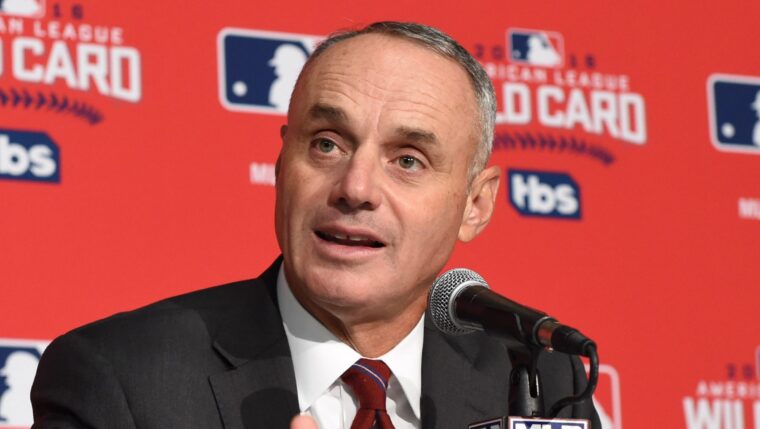
It is customary for the Major League Baseball Commissioner to give a state of the baseball union address during the all-star break. This year was no different, as Rob Manfred spoke to the press about several issues facing the game in Los Angeles before the mid-summer classic. He was joined by union lead (and former Met) Tony Clark. Here is a recap of their comments on a few of the topics they discussed.
Labor Relations
Manfred has pledged to try to create a better working relationship with the players, after the lockout that lasted for 99 days (the second longest work stoppage in MLB history). He has met with several players so far this season. Clark believes that these meetings are a step in the right direction, but the level of integrity with which MLB operates will dictate the nature of the union’s relationship with the league. In an article by Evan Drellich in The Athletic, Clark had the following to say:
“And that’s why at the end of the day, they were as unified and as solid a group as we’ve had in a long time when standing their ground for what it is they believe in. There are inherently going to be challenges in the relationship. That’s the history of management and union, management and employee. Open dialogue, candid dialogue and a high level of integrity to that dialogue has been and will continue to be beneficial. Players smell it when it’s not.”
During the lockout, both sides played the public relations game, trying to position the other side as inflexible or not wanting to strike a deal. The owners seemed content to let the lockout drag before engaging in negotiations, then during a critical point in late February, mischaracterized the bargaining sessions as positive in tone, setting the players up to take the fall when a deal was not met. The players talked a lot about competitive balance and dissuading teams from tanking, yet the settlement did not materially address this area. This calls into question if competition was ever really an important issue to the union, or if they they put that out for public consumption.
The two sides will need to align on a common vision going forward-the health of the game. If that is a shared “North Star”, integrity can more easily enter the negotiation process. If each side continues to pursue its individual objectives, often in a “win/lose” format, the owners and the union will continue to mistrust each other and future work stoppages will be hard to avoid.
Attendance
As written on MMO, MLB attendance is down 5% form the last comparator year, 2019. Manfred spins this as almost being back to pre-pandemic levels, which is fair. However, he also acknowledges that the game needs to exceed pre-pandemic attendance, and had this to say from the cited article:
“Our goal is to be higher than we were in 2019. And we need to work hard on things like pricing, promotion, to make sure that we get as many people as possible into the ballpark, always recognizing that we’re a family product.”
At least he spoke to pricing as a factor in declining attendance. He calls baseball a “family product”, but the reality is that many families cannot afford to go to multiple games per season, and some can’t afford to go to one. A family of four can realistically expect to spend about $250-$400 to go to a Mets game, when parking, gas, tolls, and concessions are factored in. Some teams have “Family Sundays” that offer reduced-price tickets and food for one cost. This type of creativity may be necessary to bring people to the ballpark, and build a new generation of fans.
Rule Changes
We know what’s on tap for next season-larger bases, a pitch clock, and a restriction on shifts. Manfred is intent on bringing these changes to the game, and per the new Collective Bargaining Agreement, he and the owners can implement rule changes. The new CBA did create a competition committee, on which the players are represented. However, the owners make the final decision.
If you followed the CBA negotiations last winter, you may not be surprised that Clark and the players are not enamored of the rule-change process thus far. From the cited article:
“While players have offered their input on each of the issues, at least the initial proposals … haven’t reflected that input,” Clark said, adding it was an “ongoing conversation.”
Whether MLB is not considering the players’ position or this is a public spin by Clark, the statement above shows that relations between the two sides have not progressed since the lockout. The rule changes are one thing, the bigger picture is somehow getting these two sides to work together. It would seem that there is a long way to go on this one.
Streaming
We know that select games are now streaming exclusively on Apple TV+ and Peacock. The entire concept of having certain games available only on a paid service (which Peacock is and Apple TV+ is not at this point) seems to run counter to the idea of growing the game. Why make games less available to fans? In his discussion, Manfred provided his rationale.
The commissioner sees baseball as being in a “transition” period in terms of television broadcasts. More people are “cutting the cord”, and turning to streaming for television, rather than cable or satellite. It seems baseball is trying to figure out how to stream games seamlessly to prepare for a future world where more and more consumers will consume content online. From the article in The Athletic, Manfred had the following comments:
“I think the larger point is this: I’m not sure we would have done, or quite frankly, Apple or Peacock would have done the deal for the games that they have, were we not in a transitional period. And we do believe that environment’s going to change rapidly. And our goal there is to have as frictionless an experience for fans to view local games as possible.”
Essentially, Manfred wants to be able to appeal to both types of consumers in the near future-those who maintain satellite or cable packages and those who choose to stream. The key will be eliminating blackouts, which may be difficult, as Regional Sports Networks hold exclusivity contracts in their markets. Those contracts may have to expire and be re-negotiated. Manfred may be following a “short-term loss for long-term gain” strategy. It may work. Let’s hope it does, because streaming is not popular with most fans at this point.
At the mid-point of year one of the new CBA, it’s fair to say that baseball has work to do. The biggest issue is waning fan interest, and the need to reach out to the younger generation. Baseball has the oldest median fan age by far of the major sports.
Making the ballpark experience more available to families by offering reduced-price deals would be a big step in the right direction. Getting ahead of the emerging shift to online viewing may also be a winning strategy in the end. One thing is clear. The game cannot significantly go forward until the players and owners start to work together and toward a common goal.
The press meeting in Los Angeles appears to have been more candid than those in years past. That’s a good start. Actions speak louder than words, as we know. There is plenty of room for action in MLB now and in the years ahead.














